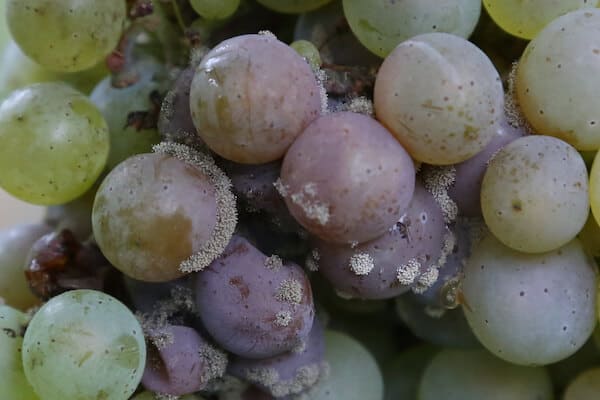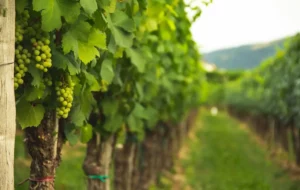Gray mold (Botrytis cinerea) is a mold or parasite that can cause considerable damage to green vine tissue and other crops such as fruit trees or ornamentals.
Varieties such as Pinot Noir, Chardonnay or Semillon are usually particularly susceptible to Botrytis due to their high sugar content. A grayish fungal turf is one of the most striking symptoms of Botrytis infestation. For this reason, botrytis is often also called gray mold, gray mold rot, or gray rot.
How does botrytis infect the vine?
The life cycle of the Botrytis fungus begins after overwintering, starting from its resistant permanent form (sclerotium). This can be found, for example, in plant residues from the previous year. In addition, under mild climatic conditions, the fungal meshwork (mycelium) can also survive the winter in the bark of the vine. Both the sclerotium and the mycelium produce spores (conidia) during prolonged periods of wetness beginning in the spring. These spores can then infect fresh plant tissue.
The primary infection of gray mold rot can already occur during flowering. Particularly susceptible to infection are, for example, the ovaries, the stigma, but also the flower caps (see Figure 1). Mycelium can now form again within the infected tissue. This may again form conidia later in the year. When infections originate from these conidia formed later in the year, they are also called secondary infections. However, these secondary infections often only occur when the berries start to color (from BBCH 83), as before this the still young berries naturally have a higher resistance to Botrytis.

Fig. 1:: The caps (1), flower base/axis (2), stigma (3), and ovary are particularly susceptible to infection by Botrytis.
What factors favor infection with the gray mold?
A warm and humid microclimate is particularly conducive to the development of a Botrytis epidemic. While, as mentioned above, long leaf wetness phases are important for spore germination and infection with Botrytis, mycelial growth within the plant tissue exclusively requires high humidity but no leaf wetness. In addition to these microclimatic influencing factors, factors such as flower residues in the grapes, compactness of the grapes or injury to grapes by hailstorms, for example, also play a decisive role in the development of gray mold rot.
As Botrytis cinerea is a weak parasite, flower debris caught between berries and damaged grapes are a popular site for Botrytis infection. If these infections form a mycelium which sporulates later in the year, the nearby grape material can now easily be infected. If the grapes are now also compactly built (no loose cluster structure), the berries infected with Botrytis do not simply fall to the ground, but remain in the cluster. This further increases the infection pressure on the still healthy berries in the grape.
The compactness of the grapes is promoted, among other things, by high rainfall after flowering, as this allows more water to reach the grapes. In contrast, precipitation during flowering, but also low temperatures during this period (<15° C), promote a loose grape structure. Research even suggests that this reduces Botrytis infestation at the end of the season, despite the fact that humid weather conditions during rainy periods initially increase the risk of infection (https://oeno-one.eu/article/view/36). In fact, the loose grape structure reduces the risk of infection for the rest of the season, overcompensating for the influence of rainfall on the infection during flowering.
Botrytis damage pattern - gray mold rot, sour rot, noble rot & Co.
Even buds and young shoots can be infected with Botrytis. Brownish discoloration, dried plant tissue and a grayish fungal lawn indicate an infestation. On young leaves, the infestation is mainly manifested by necrotic spots. If clusters are infected, brown, sometimes even black spots appear on the surface of the flower stalks and flower caps. As soon as the grapes have started to ripen, the botrytis fungus has an easy time and can infect the entire grape. The distinctive grayish absorbent cotton coating of the mycelium and the conidia of the gray mold rot then becomes visible (see Fig. 6).
Botrytis infection often develops in the grape from the inside out. Blossom residues remaining inside the grape favor the development of such a focus of infection (see above). This can also lead to infection of the stem structure of the grape (stem rot). Stem rot leads to an undersupply of the berries, which becomes visible through purple and later brown grapes (see Figs. 2 - 4). In case of severe stalk rot, grapes may even detach from the vine and fall to the ground.
If berries are infected with Botrytis before ripening, it is also called sour rot.Sour rot is often accompanied by further infections by other fungi and bacteria, which can cause additional damage to the grapes. From the complete ripeness of the grapes, on the other hand, is also spoken of noble rot, This is because Botrytis infestation may even be desirable at this stage (sweet white wines).
Source: HS Geisenheim
Conventional plant protection measures against Botrytis
In conventional viticulture, synthetic fungicides are often used to control Botrytis. Here, active ingredients such as fenhexamid, fludioxonil or pyrimethanil are important fungicides against Botrytis infestation. Important dates for the use of these botryticides are the end of flowering (BBCH 68), the beginning of grape closure (BBCH 77) and the beginning of ripening (BBCH 81).Caution: In the interests of good resistance management, care should be taken to ensure that fungicides of different resistance classes with different modes of action are used in successive crop protection measures.
Ecological measures against gray mold
In addition to these conventional methods of controlling gray mold, there are numerous biological and cultivation techniques to prevent the development of gray mold. Potassium hydrogen carbonate (baking soda), for example, shows a good effect against Botrytis for the case that the disease pressure is not too high. Recently, calcium propionate has also been found to have a positive effect in controlling Botrytis. At the present time, however, there is no plant protection product with calcium propionate as an active ingredient that has been approved for use in viticulture.
In the area of cultivation techniques, measures that avoid high humidity and promote aeration, such as defoliation of the grape zone, can have a preventive effect against Botrytis infection.In addition, infection pressure during ripening can be reduced early on by removing flower debris (blowing out after flowering). Furthermore, the risk of infection is reduced if a loose grape structure is promoted via measures such as dividing the grapes. Direct sunlight on bines, flowers and young berries (BBCH 53 - BBCH 73) can in turn increase resistance to Botrytis during this growing season.
How can a botrytis forecast help winemakers make decisions?
The nature of Botrytis forecasting differs significantly from Downy mildew and Powdery mildew. Downy and Powdery mildew forecasts help wineries to estimate the infection pressure and infestation risk of the respective disease in the coming days. If infections are predicted, a (new) plant protection measure may be necessary in advance of these infection days.
In contrast, Botrytis forecasting is about assessing whether past and upcoming weather periods (periods of several days and weeks) favor an early start of a Botrytis epidemic at the end of the season. If the signs are good for an early start of the epidemic, then the measures that favor a delayed start of the epidemic (see above) should be considered.
Forecast models can be obtained from governmental institutions (e.g. VitiMeteo). For a more detailed estimation, VineForecast offers forecasts for the entire farm area without the need to purchase weather stations.




